In this post I have explained the making of simple delay timers using very ordinary components like transistors, capacitors and diodes. All these circuits will produce delay ON or delay OFF time intervals at the output for a predetermined period, from a few seconds to many minutes. All the designs are fully adjustable.
Importance of Delay Timers
In many electronic circuit applications a delay of a few seconds or minutes becomes a crucial requirement for ensuring correct operation of the circuit. Without the specified delay the circuit could malfunction or even get damaged.
Let's analyze the various configurations in details.
You may also want to read about IC 555 based delay timers. Recommended for you!
Using a Single Transistor and Push Button
The first circuit diagram shows how a transistors and a few other passive components may be connected for acquiring the intended delay timing outputs.
The transistor has been provided with the usual base resistor for the current limiting functions.
A LED which is used here just indication purposes behaves like the collector load of the circuit.
A capacitor, which is the crucial part of the circuit gets the specific position in the circuit, we can see that it's been placed at the other end of the base resistor and not directly to the base of the transistor.
A push button is used to initiate the circuit.
On depressing the button momentarily, a positive voltage from the supply line enters the base resistor and switches ON the transistor and subsequently the LED.
However in the course of the above action, the capacitor also gets charged fully.
On releasing the push button, though the power to the base gets disconnected, the transistor continues to conduct with the aid of the stored energy in the capacitor which now starts discharging its stored charge via the transistor.
The LED also stays switched ON until the capacitor gets fully discharged.
Te value of the capacitor determines the time delay or for how long the transistor stays in the conducting mode.
Along with the capacitor, the value of the base resistor also plays an important role in determining the timing for which the transistor remains switched ON after the push button is released.
However the circuit using just one transistor will be able to produce time delays which may range only for a few seconds.
By adding one more transistor stage (next figure) the above time delay range can be increased significantly.
The addition of another transistor stage increases the sensitivity of the circuit, which enables the use of larger values of the timing resistor thereby enhancing the time delay range of the circuit.

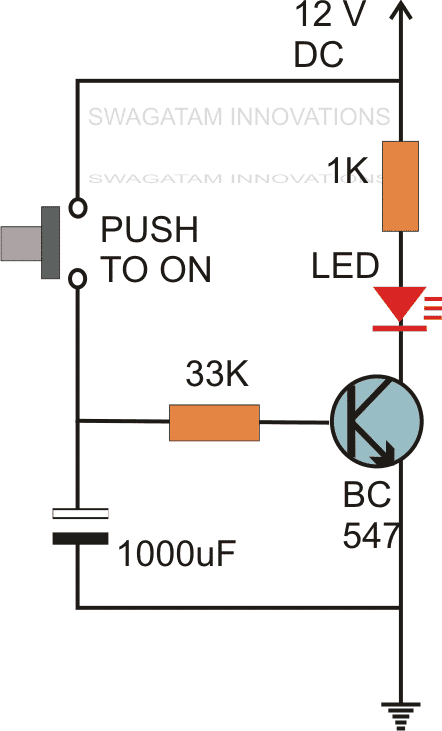
PCB Design
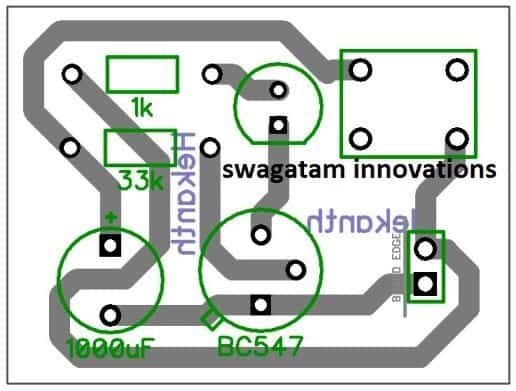
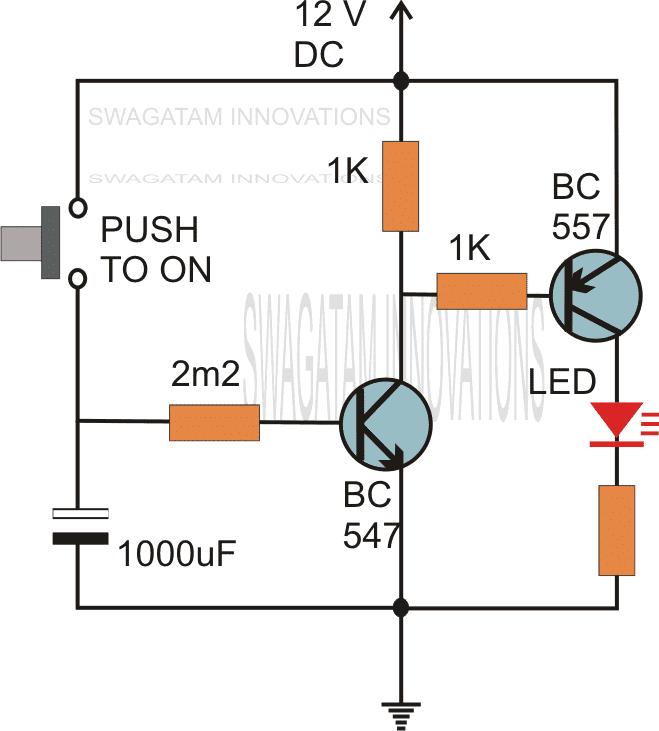
Video Demonstration
Using a Triac:
The following image shows how the above delay timer circuit may be integrated with a triac and used for toggling a mains AC operated load
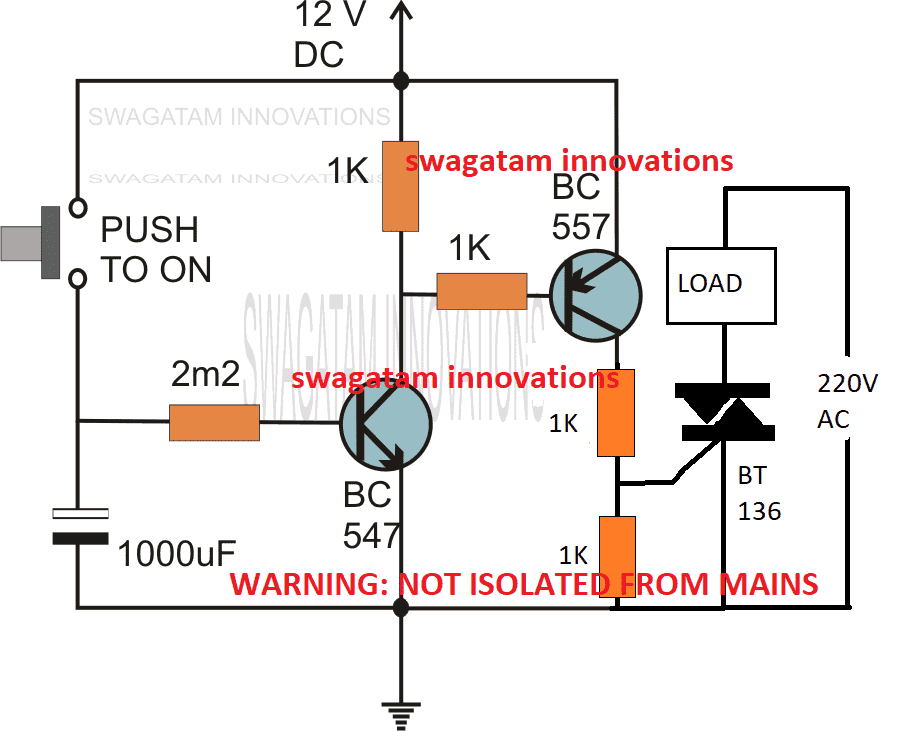
The above could be further modified with a self contained power transformerless power supply as shown below:
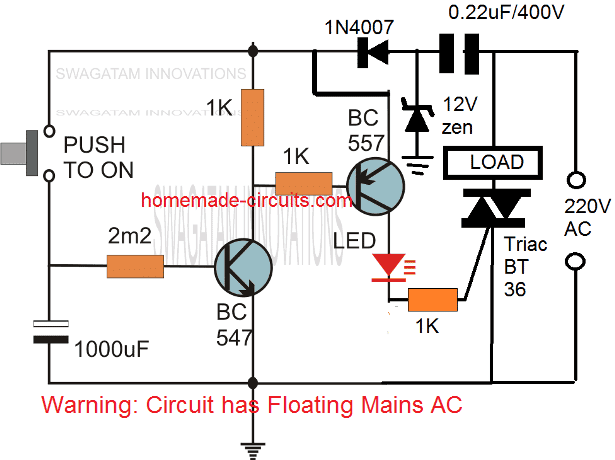
Without a Push-Button
If the above design is intended to be used without a push button, the same may be implemented as indicated in the following diagram:
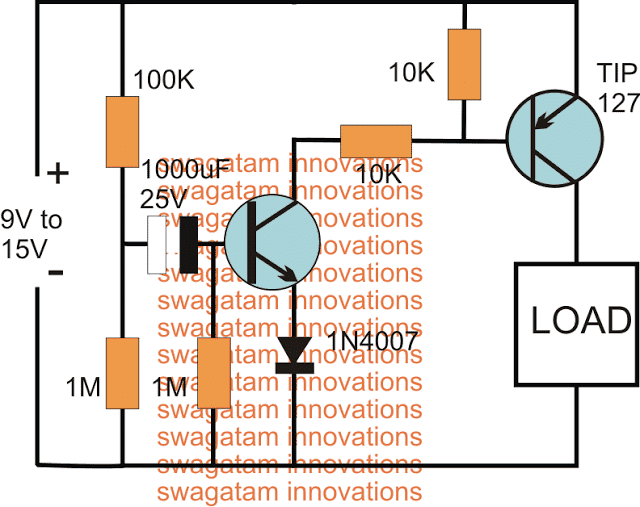
The above delay OFF effect without a push button can be further improved by using two NPN transistor, and by using the capacitor across base/ground of the left NPN
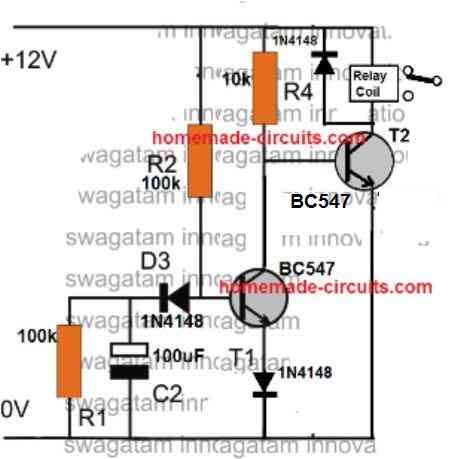
The following circuit shows how the associated push button may be rendered inactive as soon as it's pressed and while the delay timer is in the activated state.
During this time any further pressing of the push button has no impact on the timer as long as the output is active or until the timer has finished its delay operation.
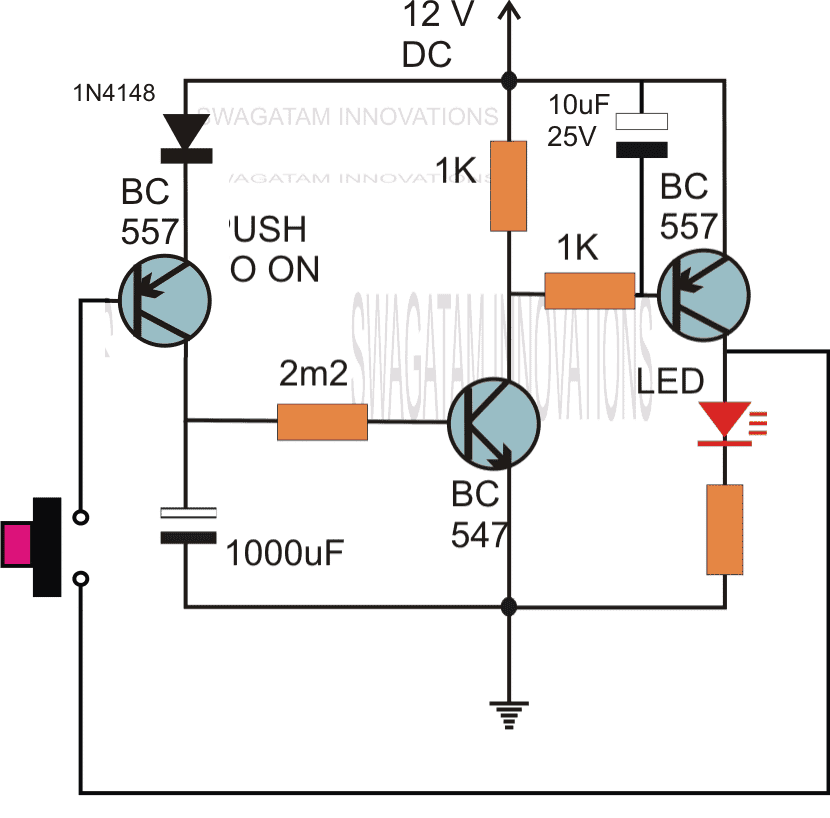
Delay from an External Trigger
Problem asked by Mr. Glen (one of the dedicated readers of this blog):
I have a situation where I have a pulse of 12V that lasts about 4 seconds (from a rotary switch being turned by a slow motor) but I only want about half a second pulse (to trigger a mechanical bell/chime).
Is there any way to take a long pulse into a circuit and send a much shorter pulse out?
The solution to the above problem is provided in the following schematic:
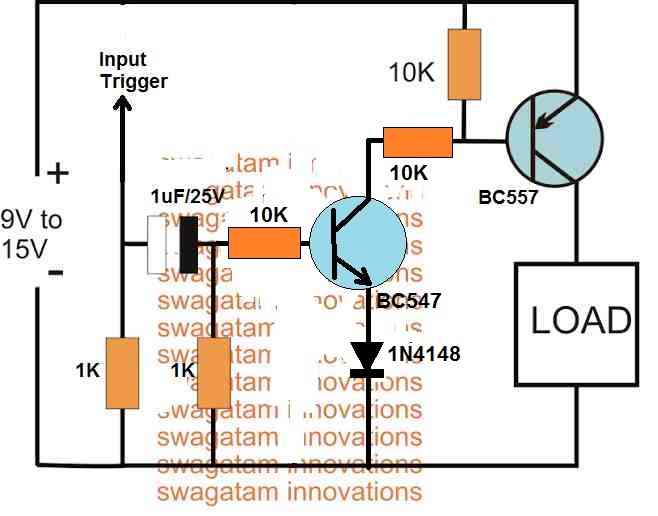
Two Step Sequential Timer
The above circuit can be modified to produce a two step sequential delay generator. This circuit was requested by one of the avid readers of this blog, Mr.Marco.
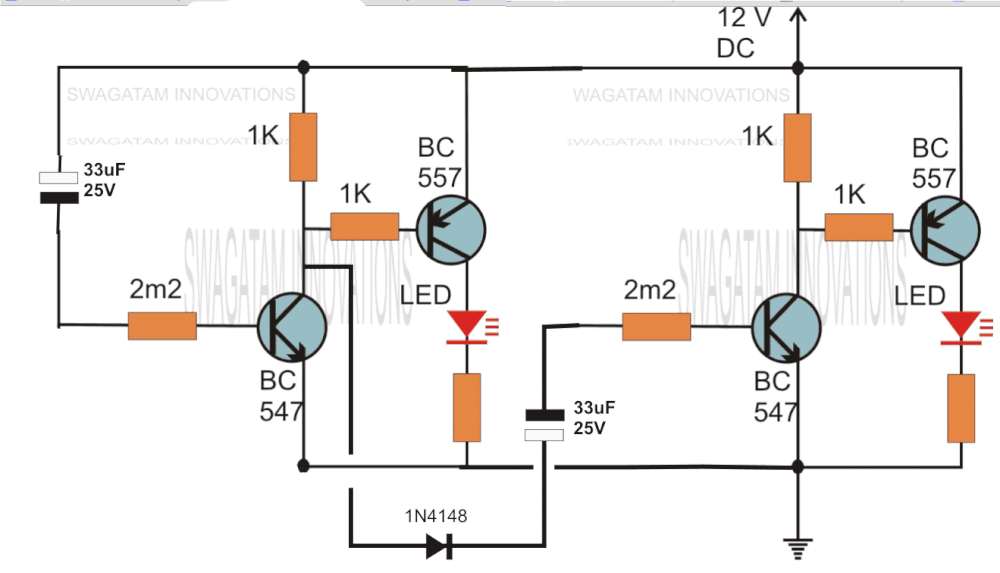
A simple delay OFF alarm circuit is shown in the following diagram.
The circuit was requested by Dmats.
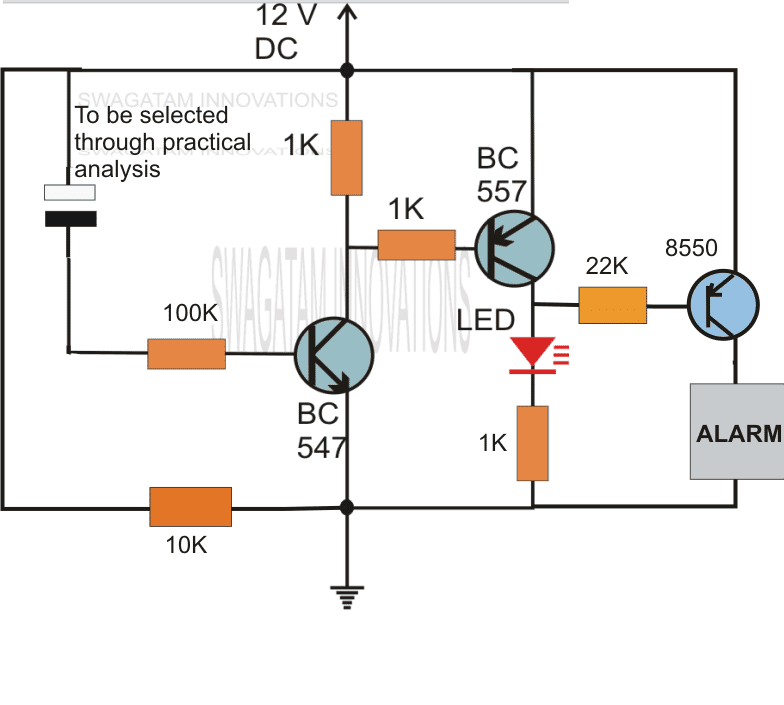
The following circuit was requested by Fastshack3
Delay Timer with Relay
"I am looking to build a circuit that would control an output relay. This would be done in 12V and the sequence will be initiated by a manual switch.
I will need an adjustable time delay (possibly displayed time) after the switch is released, then the output would go on for an adjustable time (also possibly displayed) before shutting off.
The sequence would not restart until the button was pressed and released again.
The time after the button release would be from 250 milliseconds to 5 seconds. The "on" time for the output to turn on the relay would be from 500 milliseconds to 30 seconds. Let me know if you can offer any insight. Thanks!"
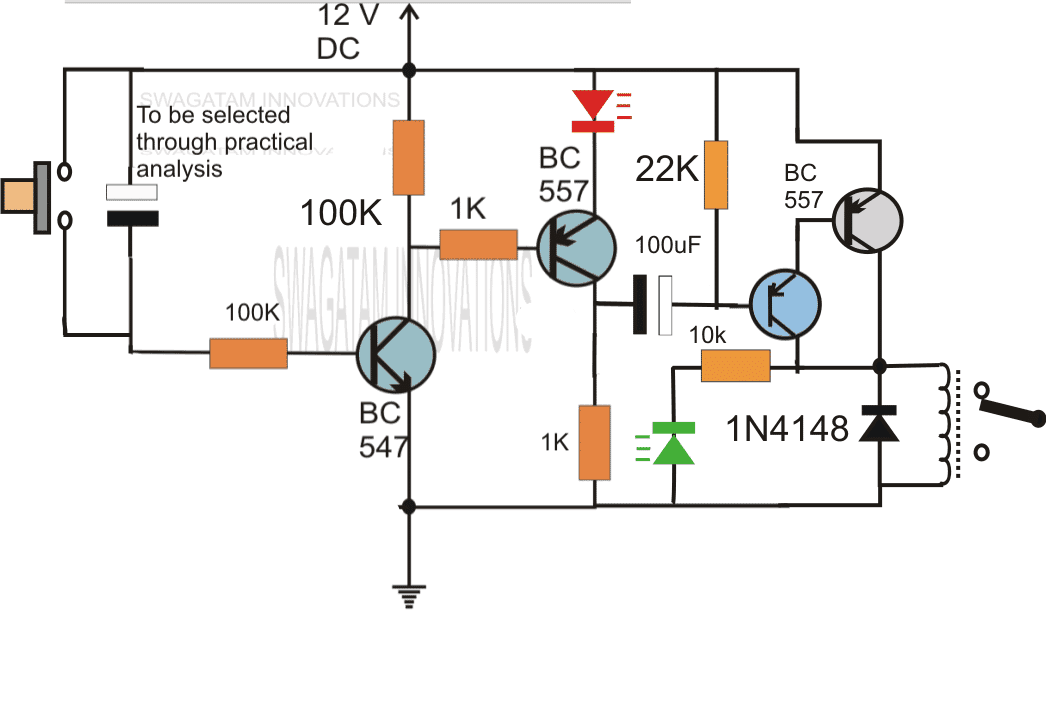
So far we have learned how to make simple delay OFF timers now let us see how we can build a simple delay ON timer circuit which allows the connected load at the output to be switched ON with some predetermined delay after power switch ON.
The explained circuit can be used for all applications which calls for an initial delay ON feature for the connected load after the mains power is switched ON.
Delay ON Timer Circuit Working Details
The shown diagram is pretty straightforward yet provides the necessary actions very impressively, moreover the delay period is variable making the set up extremely useful for the proposed applications.
The functioning can be understood with the following points:
Assuming the load which requires the delay ON action being connected across the relay contacts, when power is switched ON, the 12V DC passes via R2 but is unable to reach the base of T1 because initially, C2 acts as a short across ground.
The voltage thus passes through R2, gets dropped to relevant limits and starts charging C2.
Once C2 charges up to a level which develops a potential of 0.3 to 0.6V (+ zener voltage) at the base of T1, T1 is instantly switched ON, toggling T2, and the relay subsequently....finally the load gets switched ON too.
The above process induces the required delay for switching ON the load.
The delay period may be set by appropriately selecting the values of R2 and C2.
R1 ensures that C2 quickly discharges through it so that the circuit attains the stand by position as soon as possible.
D3 blocks the charge from reaching the base of T1.
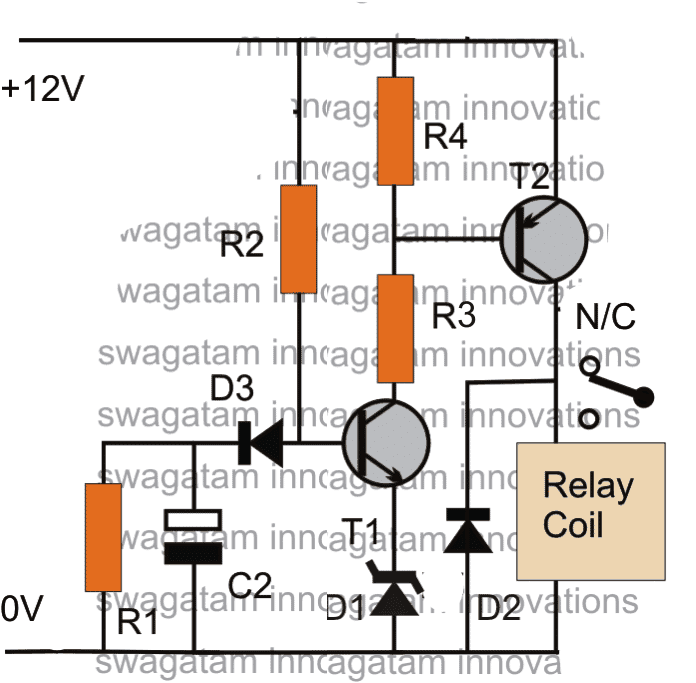
Parts List
R1 = 100K (Resistor for Discharging C2 when circuit is switched OFF))
R2 = 330K (Timing Resistor)
R3= 10K
R4 = 10K
D1 = 3V zener diode (Optional, could be replaced with a wire link)
D2 = 1N4007
D3 = 1N4148
T1 = BC547
T2 = BC557
C2 = 33uF/25V (Timing Capacitor)
Relay = SPDT, 12V/400 Ohms
PCB Design
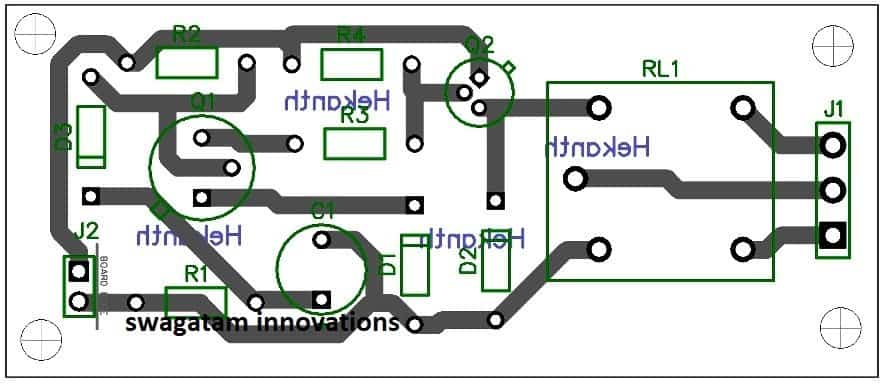
Application Note
I have explained how the above delay ON timer circuit becomes applicable for solving the following presented issue by one of the keen followers of this blog, Mr. Nishant.
Circuit Problem:
Hello Sir,
I have a 1KVA automatic voltage stabilizer.It has one defect that when it is switched on, very high voltage is outputted for about 1.5s (therefore cfls and bulb got fused frequently) after that the voltage becomes OK.
I have opened the stabilizer it consist of an auto-transformer,4 24V relay each relay connected to a separate circuit(each consisting of
10K preset,BC547,zener diode,BDX53BFP npn darlington pair transistor IC,220uF/63v capacitor,100uF/40V capacitor ,4 diodes and some resistors).
These circuits are powered by a step down transformer and output of these circuit are taken across corresponding 100uF/40V capacitor and fed to corresponding relay.What to do in order to tackle the problem.please help me.Hand drawn circuit diagram is attached.
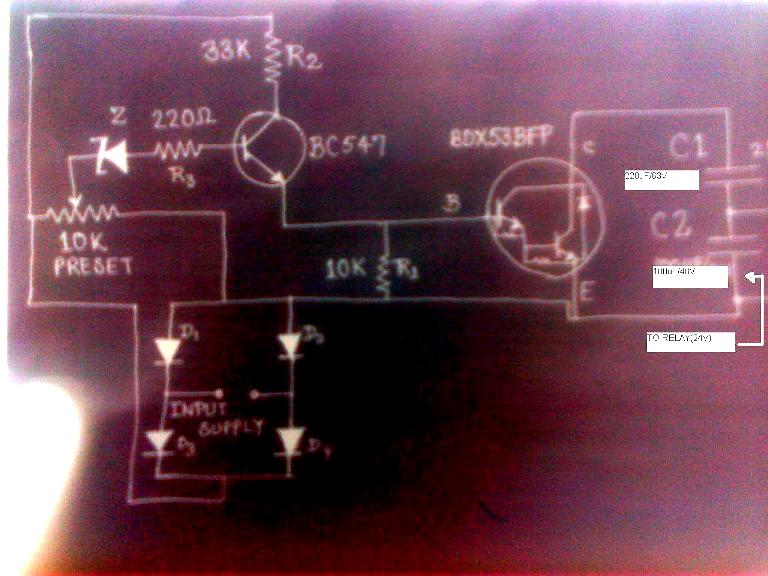
Solving the Circuit Problem
The problem in the above circuit might be due to two reasons: one of the relays is switching ON momentarily connecting the wrong contacts with the output, or one of the responsible relays is settling down with the correct voltages a little while after power switch ON.
Since there are more than one relay, tracing out the fault and correcting it can be a bit tedious......the circuit of a delay ON timer explained in the above article could be actually very effective for the discussed purpose.
The connections are rather simple.
Using a 7812 IC, the delay timer can be powered from the existing 24V supply of the stabilizer.
Next, the delay relay N/O contacts may be wired in series with the stabilizer output socket wiring.
The above wiring would instantly take care of the issues as now the output would switch after some time during power witch ONs, allowing enough time for the internal relays to settle down with the correct voltages across their output contacts.
Feedback from Mr. Bill
Hi Swagatam,
I stumbled across your page doing research on the web to make my delay more consistent.Some back ground information first.
I am a bracket drag racer and launch the car on first sight of the 3rd amber bulb as the christmas tree is coming down.
I use a transbrake switch that is depressed to lock the automatic transmission in forward and reverse at the same time.
This allows you to rev up the engine to build power for launch. When the button is released the transmission comes out of reverse and moves the car forward under high rpm.
This is like popping the clutch on a manual transmission car, anyway my car reacts to quickly and the result is a redlight, leaving to early, and you lose the race.
In dragracing your reaction time on the launch is everything and it is a game of hundreths-thousanths with the big boys, so I have put the transbrake switch on a relay and put a 1100uf cap combo across the relay to delay its release.
Because of the car electronics I don't believe there is a precise voltage charging this cap every time I activate this circuit and precision is key so I bought a power stabilizer off of Ebay that takes 8-15 volts in and gives a consistent 12volts out.
This turned my season around but i believe this circuit could be made to be more precise and to vary the delay time in an easier way rather than swap cap combos.
Also should I run a diode in front of the relay, not currently because all that is there is the on off switch- where will the current go? I am not an electrical engineer by any means but do have some knowledge from trouble shooting high end audio for many years.
Would love your thoughts- thankyou
Bill Korecky
Analyzing and Solving the Circuit
Hi Bill,
I have attached the schematic of an adjustable delay circuit, please check it out. You can use it for the mentioned purpose.
The 100K preset can used and adjusted for acquiring precise short delay periods as per your specifications.
However, please note that, the supply voltage will need to be minimum 11V, for the 12V relay to operate correctly, if this is not fulfilled then the circuit might malfunction.
Regards.
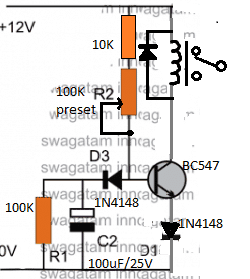
Simple 5 to 20 Minute Delay Timer
The following section discusses a simple 5 to 20 minute delay timer circuit for a specific industrial application.
The idea was requested by Mr. Jonathan.
Technical Requirements
While trying to figure out a solution to my problem on google, I came across your above posting.
I'm trying to figure out how to build a better Sous Vide controller. The main problem is that my water bath has a very high hysteresis, and when heating from colder temperatures will overshoot about 7 degrees from the temperature at which power is terminated.
It is also very well insulated, with a gap between the inner and outer vessel which makes it act like a thermos jar, because of this it takes a very long time to decline from any excess temperature. My PID controller has an SSR control output and a relay alarm output.
The alarm can be programmed as a below limit alarm with an offset from the set-point. I can use a five volt supply I already have for my circulation motor to run through the alarm relay and drive the same SSR the control output is driving.
To be on the safe side and protect the PID controller I'll add a diode to both the alarm voltage and the control voltage to prevent one output from feeding back into the other.
I'll then set the alarm to stay on until the temperature rises above the set-point minus 7 degrees. This will allow the PID tuning to be adjusted without having to account for the initial temperature ramp-up.
Because I know that last few degrees will be achieved without any power input, I'd really like a way to delay any recognition of the control signal for about five minutes after the alarm shuts off, as it will still be calling for heat.
This is the part I've yet to figure out the circuitry for. I’m thinking of a normally closed relay in series with the control output, which is held open by the alarm signal.
When the alarm signal is terminated, I need a delay on the order of five minutes before the relay returns to its ‘off’ normally closed state.
I would appreciate help with the delayed off portion of the relay circuit. I like the simplicity of the initial designs on the page, but I get the impression they wouldn’t handle anywhere near five minutes.
Thank you,
Jonathan Lundquist
The Circuit Design
The following circuit design of a simple 5 to 20 minute delay timer circuit can be suitably applied for the above specified application.
The circuit employs the IC4049 for the required NOT gates which are configured as voltage comparators.
The 5 gates in parallel form the sensing section and provides the required time delay trigger to the subsequent buffer and the relay driver stages.
The control input is acquired from the alarm output as indicated in the above description. This input becomes the switching voltage for the proposed timer circuit.
On receiving this trigger, the input of the 5 NOT gates are initially held at logic zero because the capacitor grounds the initial trigger via the 2m2 pot.
Depending upon the 2m2 setting, the capacitor starts charging up and the moment the voltage across the capacitor reaches a recognizable value, the NOT gates revert their output to logic low, which is translated as a logic high at the output of the right single NOT gate.
This instantly triggers the connected transistor and the relay for the required delay output across the relay contacts.
The 2M2 pot may be adjusted for determining the required delays.
Circuit Diagram
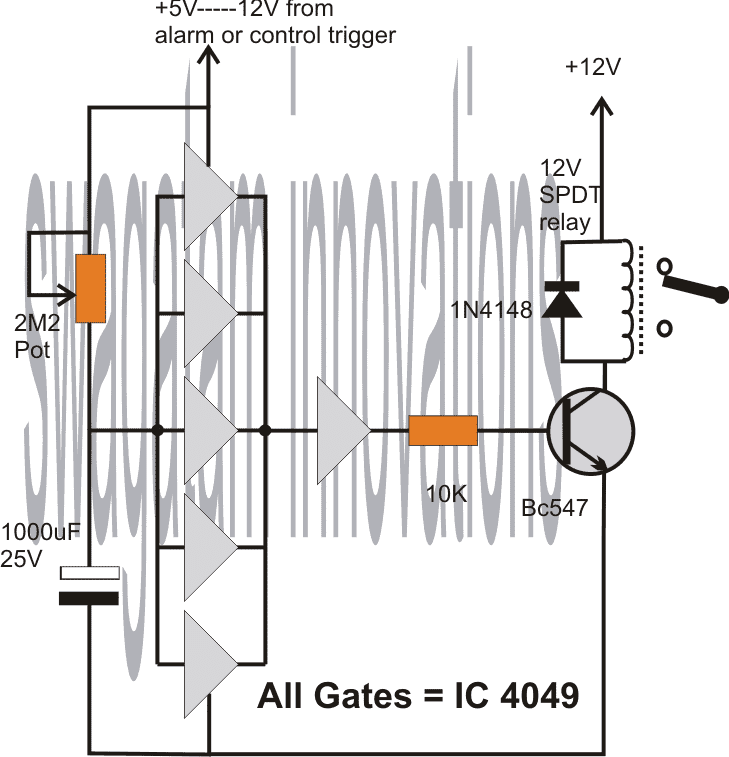

I am trying to design a circuit (I can use a 555). But I am getting lost. I need to
Output is off on power up and until I “trigger”
The trigger (which is momentary switch) (Can pull high or low)
Delay (from 250 msec to 750 msec – by swapping out resistors/capacitors)
After the delay, the output switches on – can use a FET. (I need to drive about 500ma on the output)
Ideally, I would like operating voltage from 1.5v up to say 16v and be able to have +/- 10% on the delay timing
Can you help me out or give me some thoughts on this
With a IC 555 the output will be ON for the set delay period and then switch OFF, but you want the output to be permanently ON after the delay has elapsed which looks difficult using a IC 555, but can be done using a few BJTs.
Hi
Your designs are so simple and effective. But For the above delay on circuit i am not able to find R1 – 610k anywhere in market. could you please help me out.
Thank you, glad you liked my circuits. The 610K is not critical, you can use any other value depending on how much delay you need at the output. Higher values will produce higher delays and lower value will give lower delay intervals.
I am sorry, R1 is for discharging the capacitor so that the circuit becomes ready for the next cycle, it is not for the delay periods, R2 decides the delay…you can use 100K for R1.
Hi
Im mark
Im trying to make a circuit that will send an OFF signal after x1 seconds then send ON signal after x2 seconds
And loops
I thought bout the 555 timer and a relay but how bout looping
Could u help me with this
Hi Mark, you could try a 555 and 4017 chaser circuit, pin#2 of 4017 would then give you the first x1 OFF time, next pin#2 could be combined with pin#4 using diodes for getting the 2X ON time. The subsequent Pin#7 could be connected with pin#15 for the looping action.
Hello swag….
Is there any solution for our application….
You can try the following design
https://www.homemade-circuits.com/wp-content/uploads/2018/07/press-delay.jpg
all the diodes are 1N4148.
The IC 555 output timing must be adjusted to precisely 1 second ON + OFF
The output capacitors must be also selected such that each capacitor produces a delay of roughly 1 second.
The circuit interconnections which are not shown with black dots are not connected.
yes ,delay time start after releasing the pushbutton…..
OK let me think, I’ll try to find a solution using discrete parts
i want a circuit which having a user defind relay.
There is push button in the circuit.
If i press the button for X time the out get high after x time.(Simply on led after x time).
If i press switch for 1 second then led will be on after 1 second……
sorry that looks difficult using discrete parts, a microprocessor based circuit could possibly solve it..
thank you for your reply.
Yes,it can be done by microcontroller….
Maximum delay is 5 sec ….
Now can it be possible by discrete parts ?
I think it can be possible using discrete parts, but while pressing the button some time will be used, so that much time may affect the end result…suppose you take 2 seconds to press the button 5 times, then this 2 seconds will affect the output delay time. so there should be another button which can be pressed after the trigger button is pressed 5 times, this idea may help to get the correct delay results.
Hello Swag,
Thank you for your reply,
Actually in my application, i just Have to Flash a LED.
Now the LED need to be flash at a perticular time after pressing the switch. (We need to creat a ON time dealy)
Ex :- If I press the switch for 1 Second, The LED need to be flash only after a time interval of 1 Second (After releasing the switch).
During this time(1 second) the switch will be press one time only.
Hi Ashok, OK I understood.
What will be the maximum time delay range, is it 5 seconds or more? please specify.
maximum 5 sec……
OK, but the delay ON timing will start after you release the button…
Hi,
I am looking for a way of delaying a signal so that large relays get the time to switch on, they are then latched with one of there own contacts.
The action comes from a sensor on a garden railway track that pulls a wire to 0v when a train passes over.
At present, sometimes the train is too fast to close the relay.
Your first example here would be fine, I reckon it would work with the 24v we use.
Unfortunately it needs to have an input that connects the 0v just for a moment instead of connecting the 12v to the base of a transistor and the capacitor, is this possible?
Thanks.
Hi, You can probably try the 5th diagram from top with some further modifications:
ignore the push button, connect the base of the BC557 with the 0V input source through a 10uF capacitor, positive of this capacitor should go to the base of the BC557. Make sure to connect a 220 ohm resistor in series with this 10uF just to safeguard the BC557 from high base current.
Also connect a 1K resistor from the outer negative end of the capacitor to the positive line so that the capacitor is able to discharge after the completion of each trigger
Hi Swag,
Thanks for the reply and sorry for my delay. I am now going to try to implement the delay.
Can I just confirm the drawing we are looking at is the one called the ‘two step sequential timer’?
Do I disregard the connection to the anode of the led and just connect to the base of the left BC557 with the capacitor and resistors?
Thanks.
Hi Bob,
you can try the following design
https://www.homemade-circuits.com/wp-content/uploads/2012/05/delay2Btimer2Bimproved2Bcircuit.png
yes you can disregard the feedback loop and configure the base of BC557 as per your requirement.
However the feedback ensures that as long as the LED is ON, the circuit would remain locked and not respond to any spurious or accidental input signals.
I would like a circuit to be built to control water flow from sump to overhead tank. The sensors should be positioned in such a way that it should be installed in the sump as well as overhead tank. In the sump to ensure the motor does not run dry. In the overhead tank to ensure it does not overflow and also not emptied fully.
Actually I already have quite a few similar circuits, these can be suitably combined or modified for any preferred water level control operations..
Hi,
could you please suggest me a simple circuit for “Delayed ON IC”? ( The IC should get the supply or turn ON after 3 seconds after switching ON the circuit)
Can you tell me the IC number because different ICs may have a slightly different way of implementing this….a general way can be to connect the positive supply pin of the IC through a 10 k resistor, and add a 100uF capacitor across this supply pin and the negative line
Am using IC 4093. +’ve pin is pin 14. The should get the +’ve supply after 3 seconds. So can I implement the same as u said?
yes for IC 4093 there’s no other way but to use the resistor capacitor method which I suggested earlier
Thanks. Will try. The connections is like , from the +’ve power supply to the 10k resistor, from 10k to the IC pin and the capacitor is between +’ve and -‘ve or IF and -‘ve?
yes 10k between positive line and Vcc pin of the IC….capacitor across the Vcc pin of the IC and the negative supply line of the IC
positive of the capacitor will connect with the junction of Vcc pin of the IC and 10K
How to make the IC555 to get the power supply after 5 Seconds? I tried the above one as mentioned in the previous comment with resistor and capacitor. It doesn’t work.
one of the above circuits will definitely work if you appropriately modify the design it as per your needs.
anyway you can also try the last circuit from the following article:
https://www.homemade-circuits.com/make-this-simple-delay-on-circuit/
replace the relay with the IC 555 supply pins, meaning connect the IC 555 +Vcc pin directly with the positive line, but connect the negative pin#1 of the IC to the collector of the BC547
Hello, for the last diagram, what is the number unknown transistor in dalinton pair with Bc557 on the relay coil
Hello, for the last diagram, what is the number unknown transistor
It is also a BC557
I have an LED light strip that has white and red LEDs. In order to light the colors independently, the manufacturer suggests using an on-off-on rocker switch. The LED strip has three wires.
However, in my application I can only use a simple on-off switch.
I’m looking for a circuit that would allow me to achieve this:
Turn switch on: RED lights
Turn switch off then back on within 4 seconds: WHITE lights
If more than 4 seconds go by after the switch is turned off, the next time it turns on: RED lights
I have some bulbs from a company called Imtra that does this, but they do not make light strips and I would like to achieve the same results.
Can you help? Thanks!!!
It will require some thinking…it seems it can be accomplished with a 4017 IC circuit and a delay timer…
I seek a simple transistor-based timer circuit for use in a car. There is a light which has two functions: one is to illuminate the rear number (licence) plate and the other is to illuminate the boot when the boot lid is raised and the general car lighting is off. I want the light (drawing about 1 A at 12 volts) to switch on when the circuit is first powered by opening the boot lid, and for the light to stay on for five to 10 minutes then switch off while the circuit remains powered (boot lid open and switch still ‘on’). The circuit would be reset when the boot lid is closed and the circuit is open again. In the particular car there is also a small relay which is, I think, normally closed, linking the light to all other lighting in the car. I assume that when the boot lid circuit is powered, it goes open and isolates the light from the rest of the car’s lights.
Thank you.
you can try the following design
https://www.homemade-circuits.com/wp-content/uploads/2017/12/monostable.png
the trigger from the boot lid cab be connected to the base of the BC547, this will switch ON the connected LED at pin#3 of the IC, and will keep it ON for a time period determined by the values of the 100K pot and the 220uF capacitor.
Thank you Sir for responding very very fast.
My circuit design will require to use buton cells to power up the circuit. This circuit will have to switch off the AC motor pump after exactly 10 minutes. So please let me know whether such circuit is available to run a relay of lower battery voltage.
If the supply is rated at minimum 6V, then a 5V/6V relay can be tried, however this will demand relatively high current from the cells and can deplete it quickly.
you can go for a triac instead, that will work better.
Thank you Sir for the reply. Can you name a triac to be used int he circuit instead of the transistor (i.e. label of the triac). The circuit will remain the same and the TR will be replaced by the TRIAC. Right!
Hello P GNANESWAR , I have updated the required diagram for you, in the article
I need a circuit for solar panel of say 12v to power a sump motor pump of 0.5hp. Could you please suggest any so that I can build by myself at home.
assuming your motor is rated at 220V, you will need a 500 watt inverter, a 12V 150 AH battery and a 18V 20 amp solar panel which you can directly connect with your battery for charging it, although a having a controller would make things more favorable for the battery…
Sir,
I would like to make a 10 minute delay circuit to be fitted via a relay of 3v, to power up the water motor pump. It should use either button cells of 3v or 6v. Can you suggest a suitable circuit so that when powered on the water pump will run for 10 minutes and shut off.
Gyaneshwar,
you can try the following concept:
https://www.homemade-circuits.com/long-duration-timer-circuit-using/
make sure to replace the BC557 base 10K with a 1K
Hi Swagatam, I am trying to built IOT with esp8266-01 (wifi module) to operate the 5V relay my circuit. Every think is working fine but if I will restart the system wifi get stuck (may be the drawback from load). If I remove the esp GND from relay GND wifi restart normal and after few seconds connect the GND again and working normal.
I want to add delay for 02 Sec between esp and relay.
Thanks,
Hi farid, you can try the following delay concept and see if it works for you?
https://www.homemade-circuits.com/2013/02/make-this-simple-delay-on-circuit.html
hello sir, I’m planning to build my breaklight to perform like this clip (F1 style)
https://www.youtube.com/watch?v=PQh-0bRqx3c
I did manage to buy a tiny circuit that do the flashing part, but it flash continuously
So I’m in need to build a dead simple relay circuit to perform the steady lit part, with a delay of 2 sec after connect the power supply
My led array consist of 16 leds, and there is not much room left behind the board
Could you give me a hint?
Hello Minh, due to my slow internet I could not watch the video, are you looking for a relay oscillator circuit that will switch your existing flasher after certain time interval? Just like we have in police car strobe light flashers where the lamps flash rapidly between their ON/OFF intervals??
I hope I understood your requirement.
Hi Swag, I want my brake light to operate like this: [hit and hold the brake] > light flash flash flash (maybe for 1 to 2 seconds) then lit up steadily
The “flash flash flash” part was solved with a little prebuilt circuit ($1.5), wired serial in between the power source and the light
Now I need a delay circuit to bypass it after 1 or 2 seconds to get the “steadily lit” part
Thanks in advance
Ok got it, instead of shutting the lamps during the intervals you want them to stay solid ON, this can be done using any standard IC 555 flasher circuit as shown in the below article
https://www.homemade-circuits.com/2016/07/alternate-switching-relay-timer-circuit.html
ignore the existing wiring of the relay contacts, and replace it as given below:
connect the N/O and the pole of the relay with separate wires and connect the ends of these wires across the transistor which is controlling the flashing of your lamps, or whatever “switch ” that’s used for the flashing of the Lamp
…sorry I thought you wanted the process to keep repeating…if the lamps are required to stay ON permanently as long as the brakes are applied in that case the above circuit will not work…instead you can try the first circuit as given in this article:
https://www.homemade-circuits.com/2013/02/make-this-simple-delay-on-circuit.html
wire the relay contacts exactly as explained previously
I see, so instead of using a relay to turn off the flasher and switch to continuous power source, you just let them run in parallel. So the led will be solid on after the time is up and the continuous power is on, am I right?
yes that’s right, just make sure the delay timer’s PNP is appropriately rated to handle the LED current.
so to get a 1 sec delay with that circuit what value of R2 & C2 should be used? base on your experience
Since I don’t have all those parts around to test which suit my need and have to buy them new in bulk quantity
R2, C2 will need to be experimented to get the required delay, and since 1 sec is very less, you can replace D1 with a short link….you can even eliminate the relay if you are able to configure the PNP transistor’s collector with your lamps.
the 12V to this circuit will come from your brakes….
in the end, I still have to go along the try-redo way
about the “PNP transistor’s collector” you mentioned, I have almost no knowledge about it since I’m new to this electronic stuff and still learning
All my electronic knowledge came from the days at elementary school, now it comes from gg 😀
Thanks alot for your help. Good day, sir
it’s always fun to have try-redo in electronics, and for this circuit it could be just a matter of minutes to finalize the delay parts.
If you can explain how your LEDs are configured with your flasher circuit, I may try to solve the PNP configuration details for you.
my led array consists of 16 leds, divided in to 4 parallel rows.
in each row there are 4 leds with 1 330ohm resistor wired in serial.
the array is running fine with 12v source from my brake switch for 3 years
hope you can figure it out, thanks
OK, but how is it connected with the flashing circuit, through a relay or transistor?
right now it connect directly in serial with the flashing circuit, no thing in between
use separate diodes for supplying the positive voltage to the LED module, one from the flasher and one from the delay timer, this will do the job.
meaning, break the existing flasher positive connection and put a diode in the middle.
next connect a diode from the collector of the delay timer PNP and join it with the LED positive line
Hi,
I have this device which runs on 3.7v li-ion battery
Require a simple button to activate the Same.
How much power will the first circuit consume during idle mode
Hi, all the circuits shown will not consume any current during idle mode, however these are delay circuits, pressing the relevant buttons will produce a specified delayed output
Hello Sir,pls What Is The Value Of The Unknown Transistor?
which resistor are you referring to?
Hi Swagatam,
I build the simple delay timers. They work just fine with the push button. Nice work!
However, as you have explained it is possible to remove the capacitor from its position and put it in place of the push button. This way the delay on-switch will result in the reverse, that is, in a circuit that will switch off in 2 minutes after giving power.
I removed the switch button and replaced it with the capacitor. However, it does not seem to work; the LED keeps on lighting infintely. How is this possible when the capacitor is fully loaded after a few seconds and should not feed the base? (also, after a few seconds the LED looses a little bit of intensity)
What I am looking for seems simple, my 9V boat alarm to shut down automatically after 2 minutes, so when I am not at home, the neighbourhood does not go completely haywire. The alarm gives 145 dB and will scream for hours! I only need to scare away the burglers.
Can I build this with a capacitor-transistor solution, without the use of a relay?
It looks the solution might be simple.
Thanks again.
Hi Ronald,
Both the designs will behave in the same manner, that is they will switch ON initially then switch OFF after the predetermined delay.
I think your capacitor could be leaky, because normally any capacitor once charged fully will not conduct any further…to prevent this leakage you can try adding a diode in series with the emitter of the NPN transistor….I'll try to update a more appropriate circuit soon in the above article for your reference.
Thanks Ronald, no it won't drain the battery, because as soon as it gets charged it will behave like an open circuit across its terminals.
Hi Swagatam, congratz on the good work. I also look for a same solution, in the reverse of the above.
I have simple $5 dollar alarm which is activated when a cord is pulled.
I do not want the alarm to ring for more than 2 minutes (100dB)..
When we replace the push button for the capacitor, will the capacitor create a currentleakage and drain the battery in a few days time?
Thanks, Ronald
Sorry for the missunderdtanding! I'll try to explain better.
1) The Denso relay is burned out and is out of production (nowhere to find it), so I need another circuit to repeat it's functions.The Denso company names it "starter relay", but in fact here it's used as a shutdown one.
2) The external signal of 12V that controls the relay comes only from the contact key, no buttons of any kind.
3) The diesel engine has a 12V electromagnetic shutdown valve which purpose is to stop the fuel to the injection pump, so the engine stops working when the user desides to shut it down.
4) The relay should close the circuit of this shutdown valve for few seconds only when the contact key is switched from "ON" to "OFF"(i.e. the engine is working and it needs to be shutdown). It (the relay) should not do anything when starting the engine (i.e. when the contact key is switched from "OFF" to "ON"), because if it closes again the shutdown valve for few seconds in this case, the engine will not start.
OK got it! for an accurate performance you may have to employ an IC 555 based circuit as shown in the first diagram of this article:
https://www.homemade-circuits.com/2016/11/intruder-position-indicator-security.html
Here please remove the piezo which is connected with R2, and feed the (+) input from the contact to this R2.
The LEd and its resistor will also need to be removed and replaced with a relay, as shown in this example article:
https://www.homemade-circuits.com/2014/06/input-trigger-synchronized-monostable.html
please see only how pin#3 of the IC needs to be connected with the relay, ignore the rest.
that's all, this will take of your requirement.
In the diagram from the first link, R3/R2 and C2 can be tweaked for setting up the desired delay time.
Hi,mr.Swagatam,I'm looking for a substitute for a NipponDenso starter relay, which is used on a Kubota truck to shut down the diesel engine after switching the contact key to "0" position. In order to do so, after turning off thr contact key, the original timer relay activates a valve in the high-pressure fuel pump for few seconds, which leaves it without fuel and the engine shuts down. The sequence can be repeated only if the key is switched back to "ON" position, and then to "OFF".
With other words the circuit I need should activate the output relay (and hence the shutdown valve) for adjusted time only by passing the control input (the contact key) condition from "ON" to "OFF" and not the opposite otherwise the engine will not start.
As long as I can see, the last shown circuit (requested by Fastshack3) does the right sequence of actions for me. Correct me if I'm wrong. Thanks in advance!
Hi Ivan, sorry I am finding it difficult to compare your existing relay sequence with your required circuit sequence.
Do you mean to say that you want the delay timer relay to be controlled through an external push button and not directly by the contact key?
or is it the entire sequence that you want to control through a push button by completely replacing the NipponDenso starter relay
please clarify so that I am able to help you further.
if possible please provide a step by step operational details of the circuit
one more thing that i want to turn manually on the circuit and after pushing the button it turns the relay on for 3 to 10 sec varible and then turn the relay off and when again i push the button it again run relay for required time and then set the relay in off state… can this ciruit will work( very last one)
the relay cannot oscillate since there's no feedback loop in the circuit…I am not sure what may be causing this. The concept is very simple and is explained in the article.
you can connect a 1n4148 diode in series with the BC547 base and see if that helps to rectify the issue.
helo sir i made circuit very last one 4.bp.blogspot.com/-TFvftGeJn-4/UUVoW5r9OvI/AAAAAAAADmo/JxjM1N5U5Vk/s1600/sequential+delay+relay+circuit.png
and found an error that relay continously turning on and off i mean it is triping again and again also please tell me capacitor and resistance values for veriable timing range 10 sec max thanks in advance.
HI, the circuit I am looking for is a latch which will toggle states as a flip flop will, but will not change states unless the button is held down for say 4 seconds. This is to emulate the digital life we have become accustomed to. State does not change unless we long push. I'm sure many of us wanted this circuit without knowing we did. Thanks
you can make the following circuit
https://www.homemade-circuits.com/2013/08/single-push-10-step-selector-switch.html
connect a series resistor with the push button and dimension this resistor value for getting the 4 second delay
and replace pin#10 with pin#7
ignore the relay stages, you can replace them as per your preference.
Why i can't use dc motor with first circuit? It work fine with led but it didn't work when i replace a dc motor for led.my dc motor even work with 1.5v voltage.what can i do? Thank u and sorry for my bad english
because motor require much larger current than LED….just replace the BC547 with TIP122 and it will start working
Hello there, I am student in electronics, and I was given this circuit (Two Step Sequential Timer) to rewrite it on SPICEnet, and do allkinds of simulations on it. I would like to know if any of you have any xperience in SPICE and how to simulate on it. If not I would apreciate if anyone could atleast explain me how the circuit works, and wich are the cruical elements in it.
Thanks!
Is there someone here that would be able to give some tips about how design this circuit?
I am building a combat robot for my kids, I am a machinist; this circuit is over my head.
The purpose of the circuit is to activate an air powered flipper on a combat robot.
I need a list of components and circuit diagram.
I can do the soldering.
Here is how it needs to work.
The circuit has 2 inputs:
Input 1 is 24 volts connected to LiPo batteries
Input 2 is a trigger also 24 volts
Output 1 is energized when the input 2 (trigger) is energized. It supplies current to activate an air solenoid that has a 24 volt 24 watt coil. After it is energized, it will stay on for 1 second and then turn off. (this supplies air pressure to raise the flipper)
Output 2 is energized 0.5 seconds after output 1 is turned off. It will remain energized for 2 seconds, then turn off. It also supplies current to activate a second air solenoid that has a 24 volt 24 watt coil. (this releases air pressure to allow a spring to lower the flipper)
Should I be able to do this with a circuit directly or should I expect to make the circuit low amps and use external relays?
you will need two of the following circuits
https://www.homemade-circuits.com/2014/11/long-duration-timer-circuit-using.html
and integrate the relay contact with the second circuit for executing the mentioned procedures.
please make a single module….. test it if you succeed then we can proceed for the final integration.
the 2m2, and the 1000uF will need to be drastically reduced for achieving the 1 second relay ON/OFF time….
Sir, I want a simple continuous time delay buzzer ringing every 2 or 3 minutes with volume control, buzzing time 5 seconds. Please provide me Circuit Diagram.
Prachi
praneelpune@gmail.com
Prachi, you can try the second circuit from this link
https://www.homemade-circuits.com/p/ic-555-calculator.html
by some trial and error identify the values of R1, R2, C such that T1, T2 are as per your timing specs…that is T1 could be 150 seconds and T2 could be 5 seconds or vice versa.
once these are fixed you can add a buzzer across pin#3 and ground for the required results
Can you tell me how to calculate the time constant for the first circuit? I used the formula T=RC, and used the value of base resistor as R, and got a time constant of 33 seconds, and the time to fully discharge a capacitor is 5T, that is 165 seconds, however practically it took a lot more time to discharge the capacitor. Can you please explain why this happened?
you can find the formula in wikipedia easily…
for discharging the capacitor quickly and effectively you can try the following design instead
https://www.homemade-circuits.com/2014/11/long-duration-timer-circuit-using.html
Hi,in the first circuit, once I press the button and release it, is the LED working only because of the potential provided by the capacitor, or does the battery have some effect on LED even when the button is not pressed?
Hi, the capacitor is responsible for the delay only, the LED is getting its power from the supply
Hi Swagatam,
Good day…
I hope you can help me with this, can you make me a circuit where-in when the door open,it will give an alarm so that i can hear it so that i know that what i am doing is already finish. And also,can you put a reset switch to clear the alarm once i attended to it…Thank you very much.
Hi, you can use a reed relay and magnet mechanism for sensing the opening or closing of the door.
the alarm can made by using 555 IC timer, I'll try to update the diagram if possible..
It would be so helpful if you could tell how to make the time 30 s
I'm hoping you can help me with this …. I want to add a timer circuit to a solar powered garden light. When the photo cell goes dark and turns the LED on, I would like a timer circuit to turn the LED off after an adjustable period of 4 to 5 hours. The lights are powered by a single AA battery. Thanks.
I'll try to design and post it soon….you can check back some days later
Thanks for considering this.
Have you had a chance to look into this yet ?
actually I already had a similar design in this website….I have modified it as per your request and posted at the bottom of the same article, please check out the last diagram posted in this article
https://www.homemade-circuits.com/2014/09/solar-garden-light-with-programmable.html
Hello, Swagatam, and thank-you for your work on this site. It is very impressive. I wish to make a "firefly" circuit that will light an LED for 10 seconds, turn it off for two minutes, then turn it on again for 10 seconds and so continue. I want to power this by battery and hope that this "firefly" can run for several months before draining the battery. I would like to make many of these and hang them above a street. Can you tell me whether this is possible, and, if so, how would I go about doing it? Thank-you, David.
Thanks David, a 20 second/2minute timing sequence looks too slow for a fire fly simulation, it should be kind of 1/2 second ON and 1 second OFF…to actually imitate a firefly light.
anyway you can try the first circuit configuration from this link for your application, the R1, R2, adn C can be appropriately calculated through the attached software
the LED may connected across pin#3 and ground via a 1K resistor.
sorry here's the link:
https://www.homemade-circuits.com/p/ic-555-calculator.html
HI, Do you have a variation on this circuit so that after you release the switch, the circuit remains dead for about 5 minutes and then allows the switch to be pushed again?
Hi, It can done but not with few components, it might require the involvement of an IC 4017 for a sequential delay effect, and this could make the above simple design much complex.
the negative line is also a part of the power line, if this line is cut off, the supply to the alarm circuit also gets cut of
Thanks. But I need the transistor to provide power to the alarm UNTIL it is turned on, then it needs to CUT power to the alarm for a fraction of a second to reset it. Your solution sounds like the alarm circuit negative line would only be connected to negative power when the transistor is turned on. Or am I missing something?
you can introduce an NPN transistor in series with the negative of the alarm circuit, the supply negative now gets connected with the NPN emitter and the collector to the alarm circuit negative line, meaning the NPN now acts like a switch for the circuit.
the base is connected with the delay timer NPN transistor's collector via a 10uF capacitor, the base also has a 10k resistor connected with positive.
that's all..this would do the trick.
Thanks for the formula Swagatam. I think I found a solution – I also have access to 5V in this project and when I raised the voltage to 5V the delay time increased considerably. I still need a big cap (6800 uF) but I can live with that. Maybe by experimenting with the value of the delay resistor I can reduce the cap a bit. Thanks again!
yes 5V is higher than3V so it will proportionately produce higher delay, in that case if you have access to 12V, you can apply it only to the RC network of the circuit and feed 3V to the relay…this will allow you to get much higher delays without the need of high value caps….or alternatively you can employ a voltage multiplier circuit to raise the 3V to 12V for the RC network.
Your reply: "OK, you mean to say the system requires a positive pulse for resetting the alarm…which could be probably achieved through a suitable BJT stage as soon as the delay timer is triggered…yes that's possible."
The alarm just needs to have it's 5v power cut – either + or -. Could you explain what a suitable "BJT stage" would look like? Thanks!
OK, so it may not be possible to build a 10 second delay timer circuit for a 3V relay because of their low resistance (without using an IC.) Thanks anyway for all the advice.
That's correct, it's because of the higher load current and also the 3V value which is very relatively closer to the holding threshold of the transistor's 0.6V. If supply could be increased then the timing could also be increased
OK, you mean to say the system requires a positive pulse for resetting the alarm…which could be probably achieved through a suitable BJT stage as soon as the delay timer is triggered…
yes that's possible.
Yes, I wondered how that would help. 🙂 But I still don't understand why with the relay connected I cannot increase the timing resistor beyond 40k ohms? (The transistor stops turning on.)
The 4 diode idea would effectively work for a delay ON timer, but since here we are discussing a delay OFF timer, the idea would be disadvantageous.
the base resistor directly influences the collector/emitter current specs. as it increases the collector/emitter current delivering capability proportionately decreases.
you can refer to the following article for the formula:
https://www.homemade-circuits.com/2012/01/how-to-make-relay-driver-stage-in.html
The "alarm" is actually a capacitance touch board from Adafruit and I have attached it to a metal clock to be used in a sculpture. It goes off when anyone touches the clock, but at the moment it is locking on after the touch.
I could combine your timer circuit with your transistor latch circuit and use the NC relay contacts to cut off power for a fraction of a second. But I wondered if there is a way to use a PNP transistor as an NC contact and when it is turned on after the delay it could reset the alarm? (The alarm takes very little power.)
Hi Glen, you can use an IC 555 monostable between the signal and the buzzer. This can be set for triggering for the desired length of time….but I could not understand why the alarm needs to be reset? It should have its own resetting system right?…what kind of alarm circuit are you using by the way?
Sorry Swagatam I didn't understand your answer to my question above about the 5V alarm circuit. I have a signal coming from an alarm to a buzzer. I want the buzzer to go for 5-10 seconds, then momentarily cut off power to the alarm unit so it resets. Since there is continuous power to the buzzer I don't know how to cut power to the alarm after the delay.
Thanks Swagatam. I have built a Darlington bridge with two 2N2222 transistors (that's what I had available) and the relay now latches. But I cannot get a delay of more than about 5 seconds (I need 10-15.) I have increased the caps to 3 x 6800uF but when I increase the timing resistor beyond 40K it stops working – the transistor will not turn on. Any suggestions?
that's very strange, because 6800uF is huge and should easily produce above 5 to 10 minutes of delay…I think may be your relay has a low coil resistance which is causing quicker discharge of the cap.
in that case you may need to build the second circuit, and still if it does not provide the required delay then you could probably go for an IC 555 monostable circuit
Since I am now using two transistors as a Darlington pair the circuit is almost the same as your circuit two. See the circuit diagram I sent via Google Drive. I just added your cap and timing resistor and used two 2N2222s.
I agree that the coil resistance may be the problem since when I remove the relay and just use the LED the delay is much longer. The specs for the 3V relay say 60 ohms at .15W to 20 ohms at .45W.
When I replace the relay with the LED I can also increase the timing resistor beyond 40K and the transistors still turn on – why does the relay affect how high the timing resistor can be?
Does the choice of transistors have any effect?
And finally, once we solve this problem, I need to get the final circuit as small as possible. I have read that there are Darlington pair transistors in a combined package. Would these work and can you recommend a particular model?
Yes I saw the diagram in my email, it's good.
However now I understand the real cause of the problem….it's because of the 3V supply which is much nearer to the holding threshold 0.6V compared to 12V…and that's why the capacitor charge is able to reach this limit pretty quickly.
there's one option that you can try to counter this issue….connect 4 nos of 1N4148 diodes in series with the base resistor of the transistor, this will help to increase the delay significantly even with smaller capacitor.
2N2222 is OK, the problem is not with the transistor but the voltage level as explained above.
…sorry correction: the 4 diode in series will not increase the delay in fact it will do the opposite….